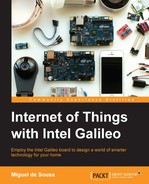As you were able to test by yourself, Galileo can be used as a small web server, being able to deliver web pages and callable endpoints. This type of server can be used to allow controlling actuators or display values that are read from the sensors in a local network.
You learned how to use a relay to control a lightbulb. Adjusting the code a bit, you will be able to control your own home lights from a computer or even a mobile device web browser. Besides lightbulbs, relays can be used to control devices such as power outlets or any other devices that have an on and off status.
Using a motion sensor and a photoresistor, you were able to understand how to make the relay actuate based on motion detection and incident light. Although we are used to see motion detection sensors heavily bounded to common spaces' lighting systems, such as entrance halls, it can also be used as a trigger in surveillance or intrusion alarm systems. Photoresistors can also have many more applications. An example can be a gardening watering system, which can use the light information to decide when the lawn should be watered.
While developing a web server to monitor and control the whole system, you came in contact with some basic web development concepts—building a simple webpage and styling it. Using AJAX, you learned how to use short polling, being able to update your web page elements without having to reload them, but with the cost of some delay. In the chapters ahead, you'll be able to explore other technologies that will help you increase your systems responsiveness.
In the next chapter, we'll be leaving the Arduino IDE and we will start exploring the Linux side of the Galileo and Intel Development Kit, discovering what it brings and how it can help you build more complex IoT projects.
